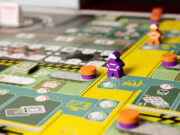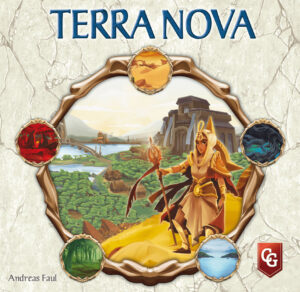 Terra Nova is an ostensibly new game from Captone Games (and venerable German publishing house KOSMOS in Europe). Authorship is credited to Andreas Faul, but a huge debt of the content is owed to the original creators of Terra Mystica, Helge Ostertag and Jens Drögemüller, because Terra Nova is not so much a truly new game as an example of asking “what if we shaved off all the rococo ornamentation from Terra Mystica so that the game could be taught in 10 minutes and everyone could just dive in?” Which is how Terra Nova saved my Terra Mystica experience from a perpetual state of “gosh, I sure wish I could learn to play this” and finally brought a version to the table for multiple plays of a really approachable, mid-weight Euro.
Terra Nova is an ostensibly new game from Captone Games (and venerable German publishing house KOSMOS in Europe). Authorship is credited to Andreas Faul, but a huge debt of the content is owed to the original creators of Terra Mystica, Helge Ostertag and Jens Drögemüller, because Terra Nova is not so much a truly new game as an example of asking “what if we shaved off all the rococo ornamentation from Terra Mystica so that the game could be taught in 10 minutes and everyone could just dive in?” Which is how Terra Nova saved my Terra Mystica experience from a perpetual state of “gosh, I sure wish I could learn to play this” and finally brought a version to the table for multiple plays of a really approachable, mid-weight Euro.
But enough about the comparisons with its sister game. Terra Nova can stand on its own as a solid, mid-weight Euro, and doesn’t deserve to be thought of only as a “dumbed-down” Terra Mystica.
Gameplay Overview:
In Terra Nova, players work to get as much of the game’s two currencies (coins and power tokens) as they can to transform the landscape into their preferred terrain type. This lets them build houses, trading posts, and fortresses, and from those components, create towns that earn sizable bonuses in currency, advancements, or pure points. Players take turns over five rounds, dropping out of each round when they run out of things they can afford to do, or perhaps earlier than that for strategic reasons. After five rounds, players receive endgame points for coins and for the relative size of their territorial reach, and a winner is crowned.
Your first game might take a while to assimilate the rules, but your second game can be finished in an hour, even with four players. It’s quick enough that after you finish a game you might want to play again as a different faction, perhaps by just flipping over your faction board and trying the other faction available for each player color.
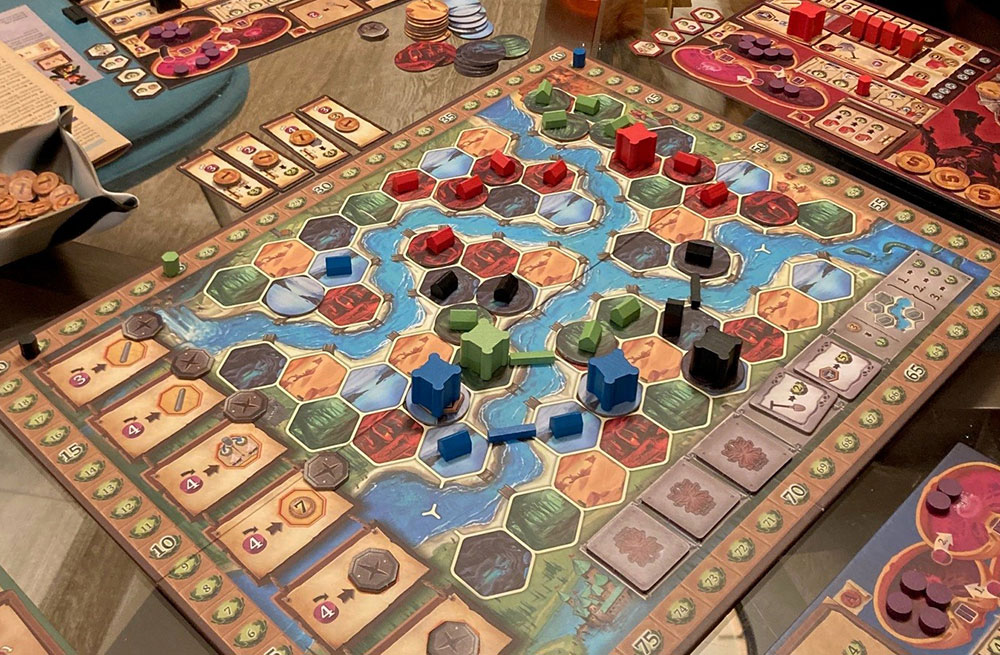
Game Experience:
If you were to open the box without any Terra Mystica experience, you might be tempted to think you’d stumbled onto an alternate-reality version of Settlers of Catan. Most of the wooden pieces seem to have been repurposed from surplus pieces from that 1995 classic. The board itself is just a bunch of hexagons, though not modular like Catan. And you even start the game placing 2 of your houses in a snake draft. But after that, the game veers off so you quickly realize you’re playing a much deeper game.
Once houses have been placed, players play out 5 rounds, taking turns in player order, each performing just one of a dozen or so possible actions. After each player has done one action, the cycle starts again, looping around until each player decides to pass and exit play for the round.
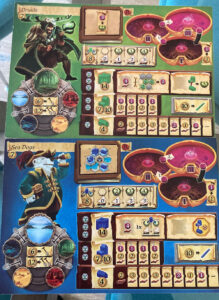
As players drop out, they claim the next space in turn order for next round, with the first to drop out claiming the first-player token (a 3D shovel), the next taking second position, etc. Players also swap out their current bonus token for a new token among those available, meaning each player’s exit affects which bonus tokens other players can get. (As you exit, you take one bonus away, but now your recently used one becomes available for players who exit after you.)
The actions themselves are centered on the concept of building towns. A town is a string of at least four adjacent buildings, with an “emblem” value of at least 7. The houses are worth 1 emblem, trading posts are worth 2 emblems, and the fortresses are worth 4. Building a house costs 4 coins, a trading post 7 or 10 coins (plus you return a house), and a fortress 14 (plus you return a trading post), so a lot of your play focuses on getting coins to allow you to build the buildings to get the emblems to get the towns.
Each building you build also uncovers a space on your player board (a la Hansa Teutonica), unlocking future income and, for your two fortresses, a special ability. As you thus grow your footprint on the map, you’re also increasing your income for future turns.
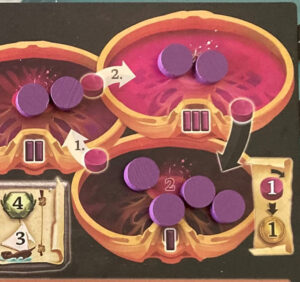
The key rule in Terra Nova (and Terra Mystica before it) is that each player can only build on one specific terrain type. For example, Faeries have to build in forest terrain and Water Sprites must build on island terrain. This means to build a town will require you to transform at least a couple of terrain hexes into your faction’s preferred color. This requires a specific action called “make habitable” but quickly everyone just referred to it as the “shovel” action because the symbol used for the action is a shovel. One shovel will transform two of the 5 types of terrain into yours, and two shovels will transform the other two, with the 5th type being pre-set for your faction’s preferences. Each shovel can be had for 6 money, but shovels can also be purchased with Terra Nova’s other currency, “Power.”
Power is a limited resource in Terra Nova. Every player starts with 8 Power, in three states of depletion and there are detailed rules that govern how you can recharge your depleted power, but in essence, you can have between 0 and 8 of these alternative coins to spend on actions. The power action spaces are only usable once per turn, so players with high power early in a turn will race to grab the best actions, turning later to coin-based actions which are infinitely available to players who have the cash.
 The game then boils down to generating the game’s two currencies (coins and power), mostly by uncovering as much of your player board as you can to expose additional income icons, and then wisely turning those currencies into buildings. To guide you towards an optimal score, Terra Nova also provides 5 sources of bonus scoring, one per round, and players are wise to focus their actions on the particular outcome that generates these bonus points. One turn might award 2 points for every shovel action you perform. Another might give 5 for each time you build a fortress. This may cause a player to exit a given round earlier than normal, saving resources to spend on the following round’s bonus activity.
The game then boils down to generating the game’s two currencies (coins and power), mostly by uncovering as much of your player board as you can to expose additional income icons, and then wisely turning those currencies into buildings. To guide you towards an optimal score, Terra Nova also provides 5 sources of bonus scoring, one per round, and players are wise to focus their actions on the particular outcome that generates these bonus points. One turn might award 2 points for every shovel action you perform. Another might give 5 for each time you build a fortress. This may cause a player to exit a given round earlier than normal, saving resources to spend on the following round’s bonus activity.
The game plays remarkably fast once everyone gets the hang of it, though if one of your players suffers from analysis/paralysis, there is plenty to cause severe brain-lock. Short of a serious AP disaster, 4 players can work through 5 rounds in an hour and change, scoring the bulk of their points as they go, and then grabbing a few handfuls of end-of-game points for the size of their territory and for their leftover coins.
Final Thoughts:
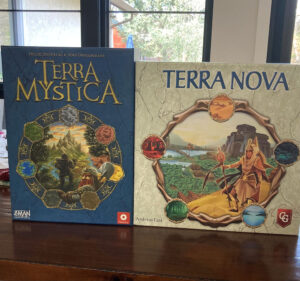
Terra Nova is less a “dumbed-down” version of Terra Mystica than an optimized version of the original: 80% of the Mystica experience in half the time and with a lot less rule overhead. Designer Andreas Faul shows us the value in taking a delicate chisel to an existing marble statue to reveal a less ornate but far more approachable work of art underneath.
Terra Nova fills a much needed niche in the spectrum of hobby games. It is a great game to help people transition from their dabbling on the fringes of the hobby and get them accustomed to the somewhat deeper waters of a solid Euro with modern mechanics and iconography. That is why I will be recommending Terra Nova to many, many people in 2023, as a Highway out of the Gateway Zone.
Theme-wise, it’s not as appealing as other go-to recommendations for post-gateway exploration (Wingspan and Obsession), but in terms of providing an easily-taught, very approachable game with enough depth and replay value that experienced gamers will enjoy helping their newbie friends expand their horizons, Terra Nova is a real treat. I can’t wait to find more chances to play it.
Final Score: 4 Stars – I could see it creeping up to a 4.5 with even more plays/time. But even if it doesn’t, I’m already personally ready to start playing Terra Mystica online, now that the foundation of the game is finally cemented in my head. Woot woot!
 Hits:
Hits:
• Easy to get to the table
• Accessible ruleset and quick(er) playing time
• Sure it’s Terra Mystica Lite; but that’s ok
Misses:
• The Terra Mystica/Nova thematic universe is pretty weak sauce, all in all. So I’m what, Leprechauns? Really? Why do Leprechauns want to build trading posts?






